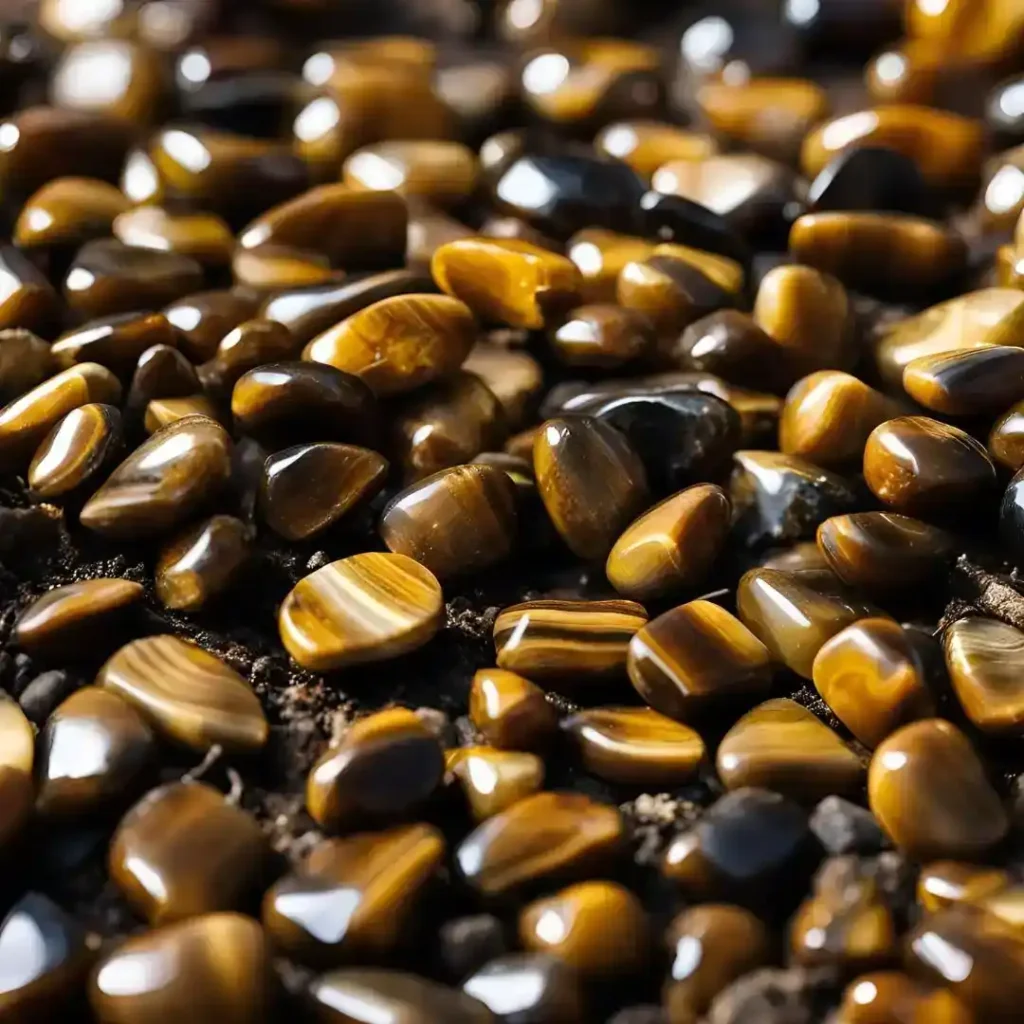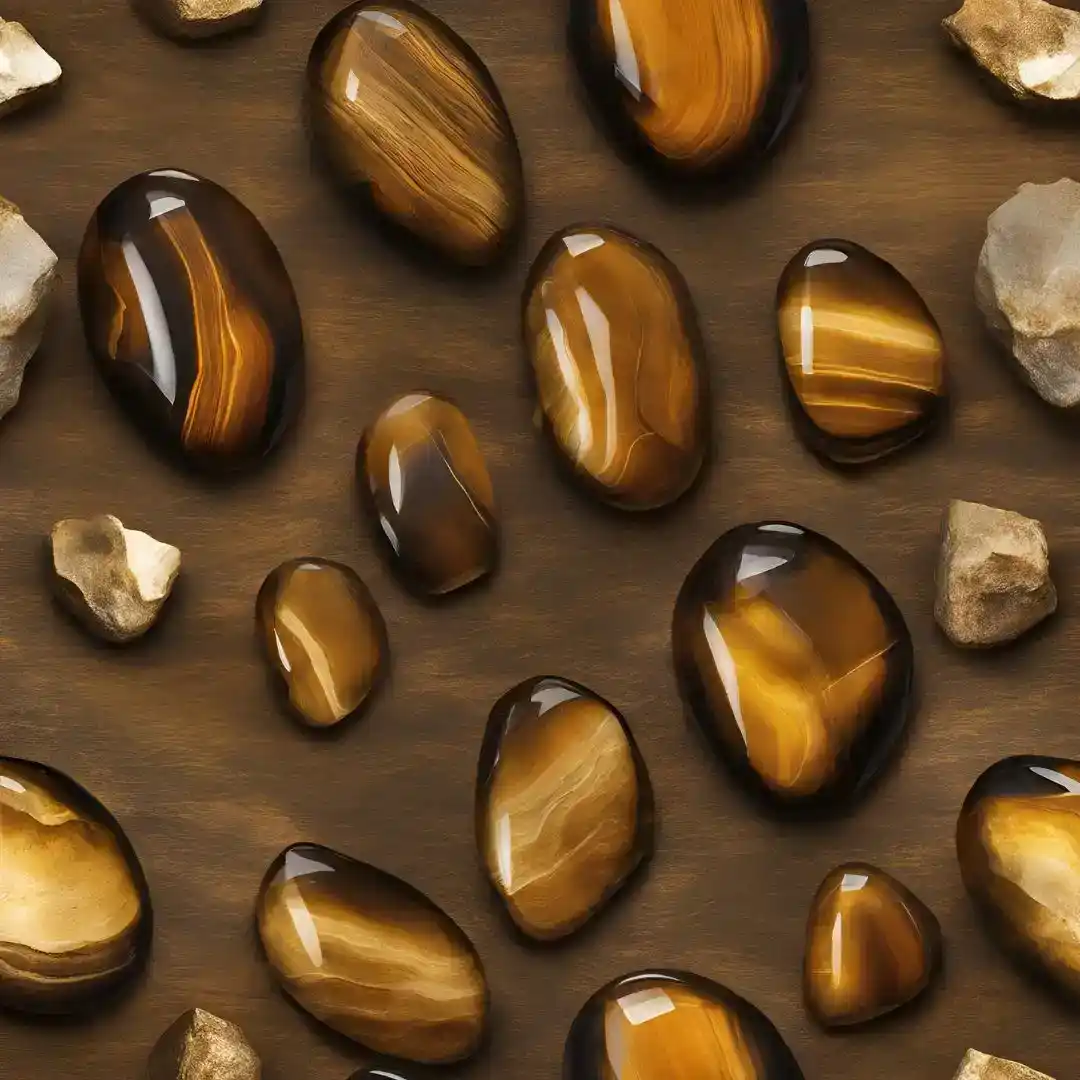Tiger’s Eye, a striking quartz crystal, is deeply rooted in ancient cultures for its metaphysical properties.
This crystal, known for its resemblance to an intense gaze, raises a common question: can Tigers Eye go into water?
While some prefer cleansing it under running water, immersing it in salt water, like a bathtub, could be damaging. It’s better to gently wipe it with a damp cloth.
Using salts directly or a saltwater solution is not recommended as they can erode the stone’s surface.
For a thorough yet safe cleaning, stick to dry methods or minimal water contact to maintain its profound beauty.
Also Read: How To Cleanse An Evil Eye Bracelet
Why Some Crystals Can’t Go Into The Water?
Tiger’s Eye, with a hardness rating of around 7, is a dense mineral often questioned for water exposure during cleansing.
Unlike some crystals, it doesn’t fare well submerged in water. This isn’t just true for Tiger’s Eye; crystals like Selenite, ranking 5 on the hardness scale, can be damaged by running water.
It’s safer to place them in a bowl of fresh air or under moonlight to keep their vibrant energy.
Saltwater can be too harsh for many crystals. For instance, submerging Selenite overnight might cause it to dissolve, losing its ability to cleanse negative energy.
The surface may erode, leaving the interior untouched but externally spoiled.
Similarly, Carnelian, being porous, absorbs moisture and negativity, which can be cleared by placing near an open window or in sunlight, avoiding smoky smells.
Labradorite and Citrine, like Tiger’s Eye, are part of the quartz family. These, too, should not be submerged as they may change colors or lose their sheen.
Also Read: How To Cleanse Your Red String Bracelet
Can Tigers Eye Go Into Water?
Immersing Tiger’s Eye in clean water can have a damaging effect on the mineral.
1. Acid Water
Tiger’s Eye should avoid the acid test; even acidic water can wear down the mineral. Strong acid exposure requires careful handling.
2. Tap Water
Using tap water, especially hard tap water with limestone, like from a kitchen sink or showerhead, is harmful. It can leave an ugly white layer on Tiger’s Eye, affecting its exterior.
With an average hardness of 6.5 – 7 on the Mohs scale of hardness, alternative cleaning methods, such as a mild vinegar solution, are recommended.
Can Tiger’s Eye Go In Hot Water?
Tiger’s Eye is a water-safe crystal. However, avoid hot water for cleansing.
Use tepid or normal-temperature water instead, to prevent releasing highly toxic chemicals that could be detrimental to both the crystal and its handler.
Can Gold Tiger’s Eye Go In Water?
Golden Tiger’s Eye, also known as alternative name for regular brown Tiger’s Eye, is a precious gemstone formed naturally by nature.
It can be safely immersed in water, maintaining its Tiger’s Eye qualities.
Can Red Tiger’s Eye Go In Water?
Red Tiger’s Eye, often a form that occurs naturally through oxidation, is extremely rare on the market.
Many available pieces are dyed or manufactured artificially. The dyed version of Red Tiger’s Eye should not be submerged in water, as its color may wane.
Can Rose Tiger’s Eye Go In Water?
Rose Tiger’s Eye, a dyed version of the regular Tiger’s Eye, should not be soaked in water.
Doing so could wash off the dye, causing the stone to lose its exquisite pink flair.
Can Blue Tiger’s Eye Go In Water?
Blue Tiger’s Eye, a naturally conceived gem from the Earth’s surface, displays chatoyant cerulean hues due to mineral inclusions during the stone’s crystallization.
It’s safe to cleanse this stone in water, complementing its oceanic colors.
Can Green Tiger’s Eye Go In Water?
Green Tiger’s Eye is a rare stone, often a fake or dyed-out version of brown Tiger’s Eye.
While the authentic stone can be cleansed in water, submerging a dyed version is highly inadvisable due to potential color loss.
Can Orange Tiger’s Eye Go In Water?
Tiger’s Eye is generally formed with a brownish-yellow hue. When it appears orange, it’s often due to certain light conditions or a brighter orange version created by heating or coloring.
The dyed version should not be immersed in water as a cleaning tool.
Can Tigers Eye Go In Salt Water?
Submerging Tiger’s Eye in salt water for cleansing should be approached cautiously. Whether using sea salt, Epsom salts, or table salt, prolonged exposure can affect the crystal.
It’s advisable to limit immersion to under an hour and avoid leaving it in direct solid sunlight afterwards, as sunshine and sun can fade the colors of the stone when placed outside post-cleansing.
Also Read: Why Did My Rose Quartz Turn White

5 Alternative Methods To Cleanse Tiger’s Eye
Tiger’s Eye, a natural stone with unique properties, needs to be cleaned for its full potential.
Here are effective methods to cleanse and enhance your crystal and quality of life.
1. Smoke It
Tiger’s Eye, an active mineral, responds well to smoke cleansing. Sage or frankincense can remove negative energy and increase positive energy flow.
Light a candle and allow the smoke to wash over the crystal, utilizing its cleansing power.
2. Put It In Soapy Water
Cleaning with soapy water and a soft cloth can remove dirt, dust, and grime. Avoid harsh cleansers and boiling water.
Submerge for no more than 10 minutes in a solution of gentle dishwashing liquid at warm temperature.
This method effectively removes oils from hard-to-reach places in the stone.
3. Leave It Outside During The Full Moon
Placing your crystal outside on a clear night during the full moon for at least 15 minutes can be very effective.
The full moon’s natural, positive, and supportive elements help minimize negative influences, leaving the energy of the Tiger’s Eye refreshed and cleansed.
This exposure to the earth’s electromagnetic field and healing vibrations of Mother Earth, even during a cold Lunar Eclipse, can transmute energies beneficially.
4. Leave It In Saltwater
Submerging Tiger’s Eye in saltwater for up to two weeks can cleanse the stone thoroughly.
The salinity helps draw out negative energy, leaving the gemstone feeling both refreshed and recharged.
Use a container filled with water and sea salt for this process.
5. Feed It Garlic, Olive Oil, And Rosemary
A unique method involves cooking ingredients like olive oil, garlic, and rosemary to create a protective film on the surface of the Tiger’s Eye.
The olive oil acts as a barrier, while garlic and rosemary not only coat the stone with a protective layer but also bring additional health benefits typically associated with these food flavors in dishes.
The importance of cleaning the crystals like Tiger’s Eye is vital in any healing practice.
It maintains the clarity and healing powers of the crystal, ensuring consistent energy flow.
The balancing and grounding benefits are enhanced with a proper cleansing method.
Spending a few minutes working with your crystal can reveal the best ways to cleanse it effectively.
Also Read: How To Cleanse Sodalite Crystal
How To Cleanse Tiger’s Eye?
To cleanse Tiger’s Eye, avoid using salt or cooking methods. A gentle dirt bath in the ground for 24hrs leaves the cleansed stone revitalized.
Be cautious with Raw Tiger’s Eye as it may have cracks. Always rinse with water afterwards.
How To Clean This Stone?
When cleaning a Dolphin Stone or Fishtail Selenite, avoid a vinegar bath as it can cause the stone to dissolve.
Instead, gently clean it with filtered water and a soft cloth, maintaining the integrity of the crystal.
Charging Water
To charge water with crystals, ensure they don’t dissolve or corrode due to the minerals.
Tiger’s Eye can be placed on the jar or water bottle lid, but not inside water, especially if it’s for human consumption.
Also Read: How To Cleanse Selenite

FAQs About Can Tiger’s Eye go into Water
1. Can I Shower With Tiger’s Eye?
Tiger’s Eye, a water-safe hydrothermal quartz, can be worn in the shower. However, exposure to chemicals or toxic substances in some bathing products can be harmful. Keep it on the outer edges of the bathtub or in a dry area of the bathroom during showering.
2. Does Tiger’s Eye Dissolve In Water?
Tiger’s Eye should not react with water. Despite its resilience, avoid placing it in environments like fancy fish tanks. This stone, formed over 10,000,000 years, does not dissolve easily, but prolonged exposure to water can cause mineral degradation.
3. Is Tiger’s Eye Sunlight Safe?
Exposing Tiger’s Eye to sunlight is generally safe, but care is needed. A bracelet or other sun-exposed jewelry can fade over time, similar to agates and other crystal jewelry. So, it’s better not to worry about brief sun exposures.
4. Is Raw Tigers Eye Safe?
Tiger’s Eye in its raw form is generally safe to touch. It is non-toxic, but it’s advisable not to eat or ingest any form of crystals.
5. Where Should I Put My Tigers Eye In My House?
Placing Tiger’s Eye in your home depends on your needs. Near your key holder or shoes for protection, or under your pillow for peaceful sleep. Sleeping With Tiger’s Eye is a matter of personal preference.
6. Can Tiger’s Eye Go In Rainwater?
Using Rainwater to cleanse and recharge a crystal like Tiger’s Eye is common. However, if it’s a dyed variant, the color might fade. Ensure to dry out the stone thoroughly after a drenching.
7. What Happens If Tiger’s Eye Gets Wet?
Tiger’s Eye, a hard crystal, is generally safe in water. Water doesn’t usually damage its properties as a semi-precious stone. In fact, moisture can enhance its natural colors and patterns.
8. Is Tiger’s Eye Sensitive To Water?
Among quartz variants like rock crystal, rose quartz, lavender quartz, amethyst, jasper, aquamarine, citrine, agate, aventurine, jasper again, tiger’s eye, and fluorite, tiger’s eye is relatively resilient. These stones can generally withstand a gentle soak. However, prolonged exposure, especially to direct sunlight, can be harmful to most gemstones.
9. Can You Charge Tigers Eye With Water?
Tiger’s eye can be cleansed and charged using various elements like earth, fire, wind, and water. Placing it in healthy soil, exposing it to smoke from a burning sage smudge or an incense stick, or gently blowing your breath over it can help strengthen and recharge its properties.
10. Can Tiger’s Eye Go In A Fish Tank?
Among popular types of crystals, like Tiger’s Eye and Agate, Tiger’s Eye can be an original, eye-catching feature in an aquarium substrate. It’s inert, meaning it doesn’t alter the pH or water chemistry of a fish tank, making it a safe addition.
Also Read: How To Cleanse And Charge Pyrite

Final Thoughts
In concluding our exploration of the topic “can Tiger’s Eye go into water,” it is clear that Tiger’s Eye crystal can indeed be safely exposed to water for cleansing and charging purposes.
This resilient stone, pivotal in aiding self-growth, can be washed to purify its space and energize it with light, effectively dispelling stagnant energy.
However, care must be taken not to overexpose it to water, as this can diminish its vibrancy and effectiveness.
Regular cleansing of the Tiger’s Eye stone, approximately every three months, is recommended, especially if it appears dirty or cloudy.
It’s important to note that while Tiger’s Eye stone can be placed near an electromagnetic device, like an oven or refrigerator, prolonged exposure to electric currents may interfere with its natural charge.
Likewise, direct sunlight can harm the stone, so it’s best to turn off the lights in a room when using it to de-stress.
Placing the stone by your bedside for 30 minutes before sleep can help calm the nerves.
For cleansing, using a water source with a gentle flow can effectively wash away negativity from the surface of the stone.
This careful approach ensures the enduring beauty and potency of your Tiger’s Eye crystal in your journey towards personal growth and well-being.
